Earlier this year I wrote a post showing what each type of Melbourne train looks like.
Here’s the tram version, in order of appearance. This is a longer post, as there’s more types.
This is the W-class tram. They’re something of a Melbourne icon, having been around (in various forms) since the 1930s 1920s, though those on the road now are mostly from the 50s. Purists don’t like that the pole has been swapped for a pantograph, but while it’s not historically accurate, I personally don’t mind how it looks. After many years of successful operation, unfortunately they are now all speed-limited to 30km/h, ostensibly a safety-measure, but ultimately to enable cost-cutting on brake maintenance.

There were 748 W-class trams built, but only 38 are in service — 12 in the City Circle fleet in burgundy paint jobs (which, again, annoys the purists). The government says all except the City Circle trams are to be phased-out. As you can see, the City Circle is amazingly popular.
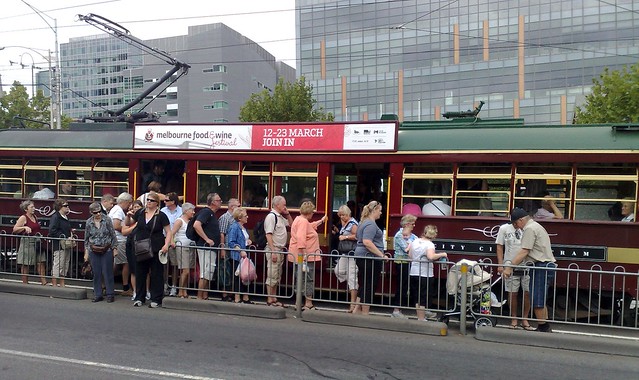
Z-class trams date back to the late-1970s to early-1980s. This is a Z1. At least I think it’s a Z1. It could be a Z2 — they are almost identical. You can tell Z-class trams apart because of their pointy nose. Inside they have a big empty space where conductors used to be seated at a booth.

This is a Z3. The notable difference from a Z1 is the presence of a small door at the rear of the tram, but they also have better acceleration, braking, and to me the ride feels smoother.
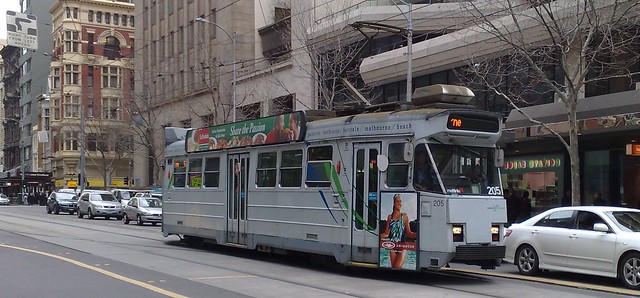
These A-class trams are from the mid-80s. They feel cramped inside to me, though they’re about the same size as a Z. Perhaps the seating layout just isn’t very efficient.
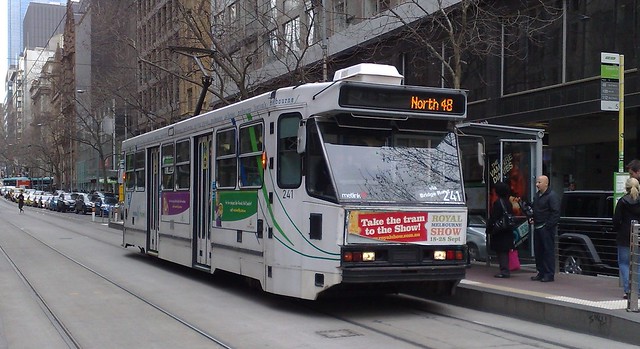
The B-class trams are from the late-80s to early-90s. There are two Bananas-in-Pyjamas-like variants, the B1 and the B2. There were only two B1s made, and they’re notable for their venetian blinds, and making the odd funny pneumatic noise. They were the first articulated trams in Melbourne, and also the first to have air-conditioning.
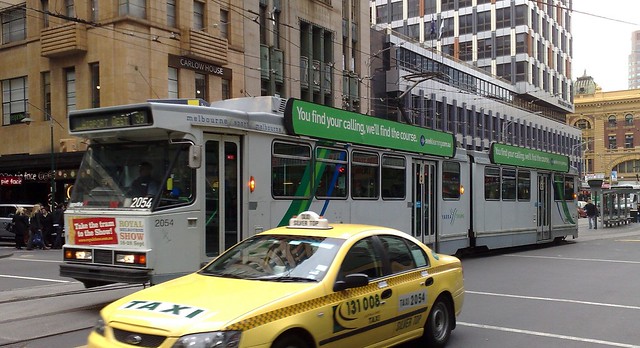
This is a C-class tram, aka a Citadis, introduced in the early-2000s as part of the privatisation deal. They’re made by Alstom, and run in numerous cities around the world. They were the first Melbourne tram to have a low-floor, thus when combined with a platform tram stop, it’s wheelchair accessible. I suspect someone decided as a cost-cutting measure not to opt for a rear door, which is a shame; it’d make the back of the tram easier to access.
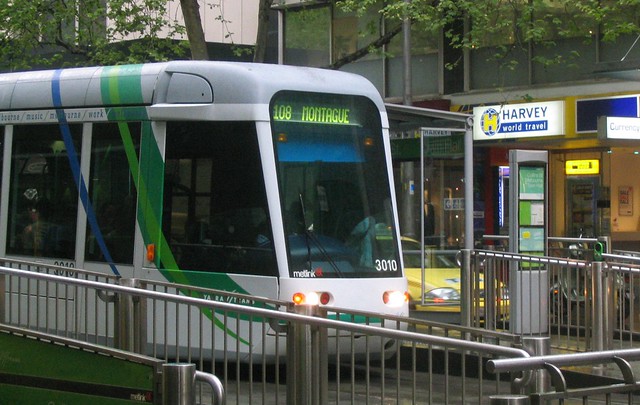
D-class (Siemens Combino) trams were also from the early-2000s as part of privatisation, and also run in a number of cities around the world. D1 is the 3-section version. They’re known for not having very many seats, in part because the wheel arches intrude into the cabin.
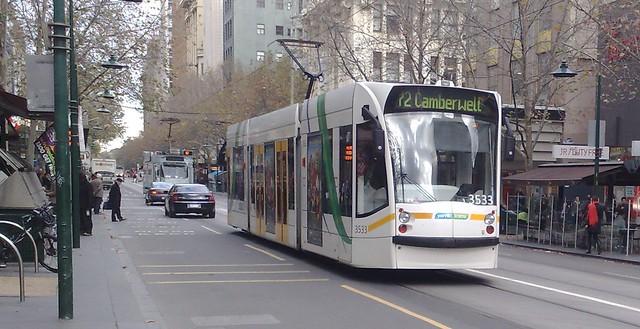
D2 is the 5-section version, a similar length to a B-class tram. Unlike Siemens trains, Siemens trams don’t suffer from brake problems, but they have suffered from structural issues requiring strengthening, which included the removal of seats, further reducing their numbers.
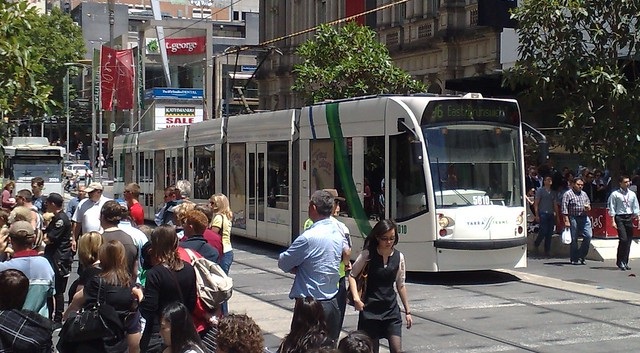
There’s one more: the C2, aka Bumblebee trams. They are 5-section Citadis trams, originally built for Mulhouse in France, but leased until December 2011, after which they will have to go back home… which is a little while before the next batch of Melbourne trams will arrive, so there could be a shortfall for a while.

We don’t know what the next model of tram will be, but they are likely to be a similar length to the Bumblebees.
30 replies on “Tramspotting”
Very informative and entertaining piece today, thanks.
Until now, I would have said there were only three types of trams.
Does PTUA have a view on whether trams should be made in Australia? Or does it come down to value for money?
Are there any plans for fleet rationalisation, or do they each have specific uses? I assume the Z/A/B are all nearing end of life, and that we have a more or less standing order for continual replacement (or would that be too logical?)
I noticed that the Z-Class looks almost similar to the Phase 1 rolling stock used on Hong Kong’s MTR Light Rail. Coincidentally, those light rail trains in HK also happen to be built be Comeng. Do I see a connection or is my long hair making me see things?
I’d completely forgotten there used to be a conductor’s booth on the Z-Class; seems so long ago now.
The Z/A/B Class trams make tram travel impossible not only for wheelchair users but for parents with prams. It’s easy enough to lift a pram up some stairs into a vehicle, but these trams’ wide doorways are obstructed by hand rails running from floor to ceiling. Why do they need those rails? Why not modify them and put the handrails on the doors? I assume these trams won’t be replaced by new units any time soon, so such a modification would probably have a life of at least a decade.
It would be OK if the C-class trams were used at regular intervals on all routes, but they’re not. The 75 route is an example. I think the C-class were used there when the route extension to Vermont South was opened, but they were quickly replaced by older models.
I wonder if the dim brake lights on the Z/A/B class trams are partly responsible for the alarming number of tram rear-end collisions too. I am amazed that these vehicles are allowed to operate without brake lights that meet ADRs for other vehicles that use the roads.
By the way, I don’t hate trams, I just hate some of these design issues that make them just that bit annoying for their passengers and other road users. These are problems that could and should be solved, but haven’t been.
@Roger, it would make sense to build the trams (and the new trains) in Australia if the price is competitive. It may be that one of the local factories (eg Bombardier in Dandenong, formerly Comeng) is able to ramp up to do it, particularly if a big/standing order is placed.
@Dave, the longer trams are generally put onto the busier routes, eg routes 19, 59, 75, 86 and 96 are almost exclusively B, D2 or C2 class trams. But many of the other routes get a mix of trams. Oh, and some types of tram run from particular depots, which would make maintenance easier.
@Haru, it’s no coincidence. The MTR Light Rail uses high platforms, but the vehicles are very similar, at least externally.
@par, unfortunately when they removed seats to accomodate the Metcard machines (which happened after the removal of the booths; for a while the Z-class trams switched to roving conductors), they failed to re-mount the seats in the spots vacated by the booths, so now there’s that big space… though arguably that’s needed these days to cater for patronage growth.
@Philip, the A-class actually don’t have the railings in the middle of the wide doorways. You’re right, it does make it difficult with a pram, particularly if the parent is on their own.
Wow Daniel, forgive me for assuming first, “Oh geez, is this a trainspotter article?’ but then ending up fascinated and informed. Truly!
enjoyed the tram description, but wanted to add that the bumblebee trams also have a locked and unusable door behind the driver on the left had side – I’ve heard somewhere that this was reserved for the driver, however I have not seen it in use … it looks to be completely bolted shut in any case (although it still has the door open button, this is disabled) …
Along with the D2, when used on the 96 route along Nicholson St, the rear doors of these trams opens out directly onto the concrete safety island which I would have thought was a big safety problem … has been like that ever since they were introduced …
@haru: the wierd thing about the HK version of the Z class trams is that they’re single ended – HK uses turning loops on their network to get around the problem but they do look odd to Melbourne eyes … presumably single-ended makes them a lot cheaper to build.
While some of the older trams lack air conditioning I think they have more comfortable seats. The wheel arch seats on some of the newer trams are poorly shaped and padded. They seem to be designed for people with only 1 leg leaving 2 legged people sitting at a funny angle with their legs and feet akwardly sharing a tiny foot space with the passenger in the opposing seat.
I also think the real “Ding Ding!” sound of bells on the older trams sounds much better than the somewhat muted “think think” sound of the electronic bells on the newer trams.
I finally bought a Myki card today. I will try it out tomorrow when my Metcard expires.
Nice round-up Daniel…. Love me my trams – we’re very lucky here in Melbourne so far as tram-travel goes.
I am just sure I will be labelled as a gunzel or some other horrible word. I was hoping someone else would say something. I guess you do know B1 trams don’t have passenger air con. Z2 trams have much larger sliding driver’s windows, except for one that must have been in a crash and has a Z1 driver’s window at one end.
Quite right Jed. Awful seats in newer trams. Z tram seats were better than W class, and nothing has been close since.
bah – ‘behind the driver on the left’ should read ‘behind the driver on the right’, naturally …
What are those two towers above the traffic light in the first photo ?
Ds, at least the 3-section ones, are foul – nasty, hard bumpy ride, stuff-all leg room, no door at the back, and very few bell points. The jolting has given me a headache more than once. I end up on one of them once a day if I’m unlucky, especially when the ones out of the Malvern depot turn around at Moreland at particular times of day. (tip: the most comfy seats are actually the inward-facing ones in the middle). The Zs, As and Bs are far more comfortable as a passenger, but as has been noted, they’re hard to get into because of the steps and rail.
enno: they’re on the Bolte bridge.
Completely agree with the anti-D1 class commenter above. You can also barely see anything out the window due to external advertising, poles and other things in the way.
The very few seats are mostly next to poles or single seats or facing sideways. And you’ll rarely get one because they’re always crowded along St Kilda Road.
Yuck
Not too far from the other Andrew above, but the other difference with the Z3 over the Z1/Z2 was the improved ‘flow through’ cooling on board, if I may call it that. The windows on these models (and the A and B1) are similar to the Hitachi and Harris trains, unlike the sliding windows on the earlier Z models where only around a quarter of the window space opens. None of this helped mind you by sealing two windows on each car for electronic destination signs!!
This coupled with the stronger extraction system make it slightly less unbearable on a hot day compared to the earlier Z models. During March and April of 2003 I rode up and down the length of High Street as part of my uni thesis and such gunzelling made its way into the report. At the time the D Class/Siemens Combinos were starting to enter service along the route – lack of seating and all!!
I recall a warmish day earlier this year when some halfwit went around the tram opening every window on a Z3 and then pulling down the shades (older light blue type, not the shade cloth stuff) half way to cover every window he had just opened!
@flerdle thanks, I thought it might be the power station, but I could have sworn it only had one chimney.
The Citadises were designed with a rear door — you can see the space for it in your photo Daniel. But for reasons unknown the Melbourne models were delivered without them. On a really crowded 109 it can be hard to get out at your stop if you’re jammed up the back. Ditto with the 5-section Combinos on the 96.
The As are a metre or two shorter than the Zs and thus have significantly smaller capacity. They are quite powerful though — they have the same motors and trucks as the Bs but in a much shorter tram (the Bs are really two As joined together, with an unmotored truck under the articulation joint in the middle).
Citadis trams being French, they are found in many of the many French cities to have opened tramways in the past decade or two. They’re also in Dublin. Specially armoured ones have been built for Jerusalem, where a tramway system is close to opening.
Combinos being German, they are found all over Germany, as well as in such cities as Amsterdam, Bern and, believe it or not, Hiroshima, which imported them by air in one of those giant Russian freight planes.,
No Citadises operate in Germany, and no Combinos in France, so it looks like protectionism is alive and well there despite the EU.
IMO the Citadis is a far superior tram to a Combino, but here in Melbourne, the tram drivers love Combinos and hate Citadi.
We ended up with these two models rather than one order of similar trams because the Victorian government let the original two operators get the trams they wanted…. Yarra Trams being French owned bought Citadi and Swanston Trams (can’t remember who owned them) bought Combinos.
That mistake won’t happen when an order for 50 more trams is announced in the next week or so…. Combinos aren’t even on the short list, which is between Citadis and Bombardier (which wants to build them at Dandenong if it gets the order).
Yes I suppose this makes me a gunzel.
@David McLoughlin: Do you have any links for this? I’d be interested in taking a look at the new fleet online …
@David McLoughlin Here’s hoping we have them made here by Bombardier
Thanks for posting this, Daniel. Thing have moved on fro the days of W, Z, A and B only…….
(Oh and “hello” David M! Very many years since our online paths have crossed!)
Very informative summary, Daniel, and I agree with flerdle’s list of the nasty features of the D-class (Siemens Combino) trams. The Siemens trams are my least favourite type as well.
I find it hard to believe that anyone from Siemens who was involved in the design of those trams ever actually took a trip on a prototype tram before the manufacture of them commenced en masse. How the hell is the average person meant to squeeze his or her bottom into one of those tiny, tiny seats near the wheel arches? Under normal circumstances I get very annoyed by people who spread themselves unnecessarily over two seats, or who sit in the aisle seat when the window seat is free, forcing me to clamber over them in order to to sit down. But on the Siemens trams, I’m prepared to forgive them – one just cannot fit into those ridiculous seats. Perhaps all of Siemens’ test passengers during the testing stages were whippet-thin models or small children.
My other giant peeve is the paucity of buttons to signal to the driver that you want the tram to stop. There are – what – six buttons in total on the whole tram, one next to each door? Four of them in the central compartment and one at each end? However many it is, it is grossly inadequate. On the older style trams, no matter where a passenger is located, the cord, if not a button, to signal the driver is almost always within arm’s reach. On the Siemens trams, there is no cord at all, and when the tram is only moderately full, the nearest button can no longer be seen, let alone reached, because of the mass of passengers standing in the way. More than once I have missed my stop because I have not been able to fight my way to the door in time, and my pleas to fellow passengers to push the button for me have been ignored. I remain flabbergasted that these stupidly designed trams ever got off the drawing board.
Whenever I see a government figure – Brumby, Pakula, Kosky, whoever – doing a photo op on board a train or a tram, I have to resist the urge to throw a brick at the TV. Yeah, right. They go all the way from Parliament to Spencer Street or North Melbourne – wow, such a distance! – and then get their government car (complete with government-provided driver) to bring them back. They have no idea what it is like to catch public transport every working day. These publicity photo shoots make me sick.
I still remember seeing Cain government transport minister Peter Spyker occasionally during the 1980s, catching the train to the city on the Frankston/Dandenong line (not sure which, because I got on at Malvern), and talking to his fellow commuters. (And with never a photographer to be seen.) I don’t know whether Spyker did it every weekday, but word amongst the passengers I spoke to was that he did it regularly enough for them to believe that he was a genuine commuter, as opposed to an MP taking part in a photo op. That’s around 20-25 years ago now. Shame that it has been that long since I’ve had any genuine respect for a transport minister.
Thanks to Yarra Trams a few years back at some event, I have a very nice wall poster on my door that shows and describes the different trams going way back from past to relative present.
I find it very handy.
Surely there has to be more of them out there, or maybe a PDF for others to download and enjoy at worst.
Would this be worth investigating? (It was before the recent change of management for YT.)
regarding prams on z (and B) trams…
As new parents we made sure we didn’t get a ridiculously wide pram and have no problem getting onto Z3 trams on route 57.
The vacant conductor post makes for a nice space to park the pram too :-)
We haven’t tried a B2 though, once you get on board there’s no room for a pram anyway.
A lot of it is about choices – you buy a pram to use, not to impress everybody else :-)
…and as somebody with dud knees I find the centre handrail on Z3’s really handy – the ones on the doors are too flimsy (and the doors move a little)
Never had a problem getting a stroller onto a B2 on the 86 except the time my wife borrowed a double stroller to accomodate an extra child (she does family day care), and even then I got it on eventually by removing the kids and curving it round the pole as I got on… (after much impatient dinging of the bell by the driver)
“They” have started changing the seat configuration on the Siemens Combino (5 section) trams, by turning around the double seats near the doors so you face away from the doors (rather than towards them) and sit facing the people in the next set of double seats.
Due to the back of the seat now being against the pole with the green validator or the myki validator, there is a lot less leg room for the people in the seats that have been turned around, and also the seats they now face.
Yarra Trams responded to my complaint about less leg room by saying this is part of the body strengthening required on these trams, under an agreement between Siemens and the State Government (ie nothing to do with Yarra Trams and nothing they can do about it).
Turning around the seats for body strengthening? Seriously, someone must be having a lend of us…